Abstract
Spatially uneven urbanization shapes various urban-lake spatial patterns; however, the effect of pattern evolution on lake breeze front (LBF) penetration via thermal and aerodynamic mechanisms in inland multi-lake megacities remains unclear. Therefore, sensitivity experiments were conducted to examine LBF changes over the past 40 years in Wuhan, China—where lakes are located on the periphery of built-up areas or integrated with urban fabrics—using the Weather Research and Forecasting (WRF) model under high-temperature and weak-wind conditions. Moreover, we quantified the contributions of thermal (lake-land surface temperature differences (LSTD), urban heat island intensity (UHII)), and aerodynamic factors (lake-land surface roughness differences (LSRD)) to LBF penetration. The results showed that for lakes entirely within urban fabrics, the thermal and roughness characteristics at lake-land interfaces dominated LBF penetration. Specifically, urban expansion towards lakeshores without connections promoted LBF penetration due to the stronger positive benefits of the LSTD. However, urban expansion bordering lakeshores inhibited LBF penetration, as the inhibitory effects of LSRD outweighed those of LSTD. When lakes remained on the periphery of built-up areas, higher UHII and the UHII-weighted center moving towards suburban lakes accelerated the LBF movement into built-up areas. Based on these findings, we propose adaptive strategies for urban growth boundaries to facilitate the natural infiltration of LBFs into urban environments.
1. Introduction
The synergy of global climate change and urban heat island (UHI) effects leads to a considerably higher increase in ambient temperatures within urban areas than the global average, posing substantial risks to energy consumption, peak electricity demand, air quality, heat-related mortality, and morbidity [1,2]. Recently, there has been increasing interest in nature-based solutions (NBS) for mitigating urban overheating, as emphasized in “Beating the Heat: A Sustainable Cooling Handbook for Cities” [3] and “Urban Cooling Toolbox” [4], highlighting the crucial role of NBS in cooling urban environments. Waterside cities are exploring the implementation of blue infrastructure to counter urban overheating, with coastal cities leveraging sea breeze circulation (SBC) and inland cities employing lake breeze circulation (LBC). Strategies include managing urban growth boundaries (UGB), establishing urban ventilation corridors, and controlling development density along water bodies to enhance natural ventilation through SBCs and LBCs [5,6,7,8]. Utilizing water-land breeze circulations generated by blue infrastructure has great potential as a nature-based solution for promoting cooler cities.
The characteristics of water-land breeze circulations penetrating the surrounding areas are the passage of a front, representing the arrival of cool and humid airflows [9,10,11]. The thermal and aerodynamic characteristics of urbanized areas may influence the penetration of water-land breeze fronts as they pass through built-up areas [12,13,14]. However, rapid urban expansion has transformed natural areas into built-up areas, resulting in changes to thermal properties such as heat capacity, albedo, and emissivity, thereby affecting the surface-atmosphere energy balance [15]. Furthermore, the aerodynamic attributes of built-up areas, characterized by high surface roughness, significantly alter near-surface wind patterns and turbulence [16]. Therefore, revealing the interaction between urbanization and water-land breeze fronts is vital for optimizing natural ventilation and reducing urban heat stress by fully leveraging the cooling capacity of the blue infrastructure [17].
Previous climatology studies have investigated the interactions between urban expansion and the infiltration of sea breeze fronts (SBF) and lake breeze fronts (LBF) in coastal and lakeside cities at a regional scale. Before SBFs reach urban areas, the convergence zone generated by the urban heat island (UHI) could draw SBFs toward the urban center with an accelerating movement pace [18,19]. Once SBFs reach urban areas, the surface roughness of built-up areas slows down SBF penetration [20]. When urban areas are located some distance from the coastline, the inhibitory effect of urban heat island circulations (UHIC) on SBFs persists until the dissipation of UHICs. This is because UHICs have already developed vigorously before SBFs reach urban areas [21]. Overall, the SBF-urbanization interactions have been attributed to the influence of UHI, surface roughness in built-up areas, and city-coastline distances, and the relative contribution of UHI and surface roughness in built-up areas to SBF penetration distances varies with different city-coastline distances. However, in lakeside cities, most earlier studies have mainly focused on the combined urban effects on LBF penetration, with less consideration for distinguishing thermal and aerodynamic effects. For instance, Suzhou’s expansion from 1986 to 2006 promoted the penetration of LBFs from Lake Taihu (2250 km2) toward the urban center by approximately 15 km without an examination of the influencing factors [22]. Therefore, isolating the influence of thermal and aerodynamic attributes is essential for dissecting the spatial patterns, penetration distances, and generation mechanisms of LBF activities.
Despite urban expansion, urban areas and the sea (or great lakes) remain separate at the regional scale, even though urban areas may extend close to the coastlines (or lakeshores). However, urban expansion at the city scale may lead to various spatial patterns in urban lakes, such as lakes connected to urban fabrics or lakes encircled by built-up areas. In recent years, with the refinement of numerical models and improvement of shallow lake schemes [23,24,25], researchers have employed the Weather Research and Forecasting (WRF) model incorporating shallow lake schemes to investigate the temporal variations of LBCs generated by relatively smaller lakes within urban areas and their LBF penetration characteristics. In a previous study, it was found that LBF occurrence periods exhibited significant variations related to the size, shape, and location of lakes (1~200 km2) in Wuhan [26]. Moreover, LBFs from upwind lakes exerted a greater influence on built-up areas than those from downwind lakes. Hence, the proposed strategies include limiting UGB expansion around upwind lakes and considering the group arrangement of built-up areas around downwind lakes to maximize the coverage of LBF influence areas [27]. In general, current research has primarily focused on the combined urban effects on LBF penetration under existing urban development conditions. However, it remains unclear how the evolution of urban lake spatial patterns resulting from spatially uneven urbanization may impact the contribution of thermal and aerodynamic factors to the spatial heterogeneity of LBFs.
Accordingly, this study evaluated the penetration of LBFs in response to the evolution of urban-lake spatial patterns from 1980 to 2022, using Wuhan, a typical inland multi-lake megacity in China, as a case study. To achieve this, we conducted various sensitivity experiments in 1980, 2000, 2010, and 2022, representing the typical evolutionary process of urban lake spatial patterns using the WRF model coupled with the shallow lake scheme under high temperature and weak wind conditions. The objectives of this study were to (1) investigate the influence of different evolution processes of urban-lake spatial patterns on LBF penetration, (2) quantify the thermal and aerodynamic contributions to LBF penetration distances under various urban-lake spatial patterns, and (3) propose adaptive strategies for UGBs to facilitate LBF infiltration into urban environments. Our research contributes to maximizing the role of LBFs in naturally cooling urban fabrics.
2. Materials and Methods
2.1. Study Area
The city of Wuhan (29°58′–31°22′ N, 113°41′–115°05′ E) is situated in the Jianghan Plain in central China (Figure 1). It is one of China’s megacities, with a population exceeding 10 million. Referred to as the “International Wetland City”, Wuhan is crisscrossed by a network of rivers and lakes, accounting for one-fourth of its total area. Wuhan experiences a subtropical monsoon climate (Köppen: Cfa), characterized by high temperatures and frequent periods of calm winds in summer. Annually, there are an average of 71.2 hot days (>32 °C), including 12 extremely hot days (>37 °C), with air temperatures peaking at 39.8 °C. Moreover, the average summer wind speed is 1.6 m/s, featuring a 10% frequency of calm winds and prevailing southeast winds in summer.
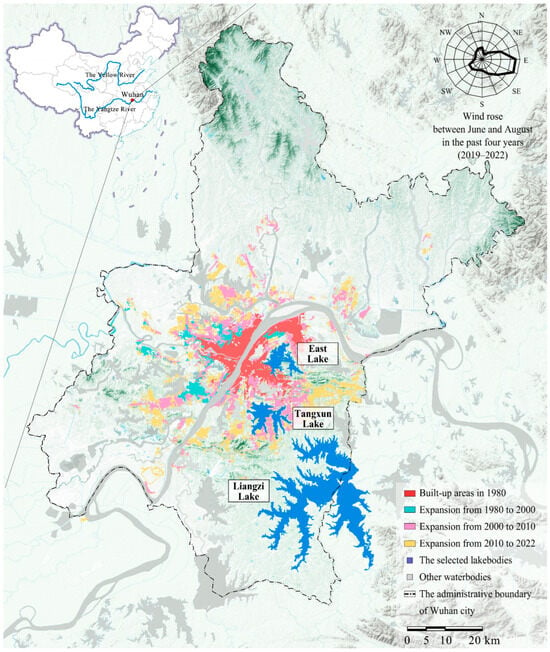
Figure 1.
Lake distribution and expansion of built-up areas in Wuhan from 1980 to 2022.
Between 1980 and 2000, the growth of built-up areas in Wuhan remained relatively slow, increasing by 33 km2 at an average annual growth rate of 0.8%. However, after 2000, Wuhan experienced a period of rapid expansion, with built-up areas expanding from 209.99 km2 in 2000 to 500 km2 in 2010, marking an average annual growth rate of 8.2%. Subsequently, from 2010 to 2022, the expansion rate of built-up areas decelerated to 4.5%, resulting in an increase of 385 km2 [28] (Figure 1). The spatial relationship between built-up areas and lakes continuously evolves due to uneven urbanization processes. Some lakes remain on the periphery of built-up areas, while others are entirely enveloped by urban development. Therefore, we selected Liangzi Lake, East Lake, and Tangxun Lake as the focal points of our research (Figure 1), representing diverse evolution patterns of urban-lake spatial relationships. Of these, Liangzi Lake remains situated at the periphery of built-up areas, while East Lake has transitioned from being “alongside the lake” to being “integrated within the urban fabric. Tangxun Lake has shifted from the periphery to being entirely encompassed by built-up areas. All three lakes are positioned upwind of the built-up areas under prevailing summer wind conditions. This ensures that their LBFs can interact with urban areas, while those located downwind or crosswind typically exhibit little or no interaction with these areas. Selecting only upwind lakes also minimizes the confounding influence of wind direction, allowing for a more accurate assessment of the other contributing factors.
2.2. Methodological Framework
An overview of the methodological framework implemented in this study is presented in Figure 2, which involves three steps: WRF simulation platform, scenario design and modeling, and analytical methods.
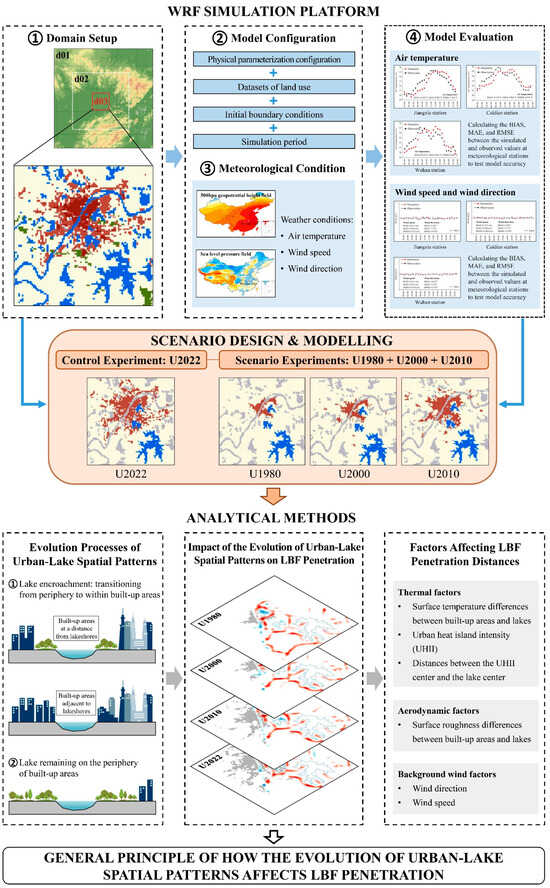
Figure 2.
Methodological framework implemented in this study.
2.2.1. WRF Simulation Platform
- (1)
- Domain setup and model configuration
The modeling system utilized in this study was WRF version 3.9.1. The horizontal domain was composed of three nested domains with grid points of 55 × 55 (9 km), 94 × 94 (3 km), and 169 × 169 (1 km) (Figure 3). The innermost domain (d03) covered East Lake, Tangxun Lake, Liangzi Lake, and all of Wuhan’s built-up areas in 2022. In the vertical direction, 45 levels extended from the surface to the top level of 50 hPa, of which the lowest 15 levels were applied below 1 km to achieve a finer resolution in the planetary boundary layer.
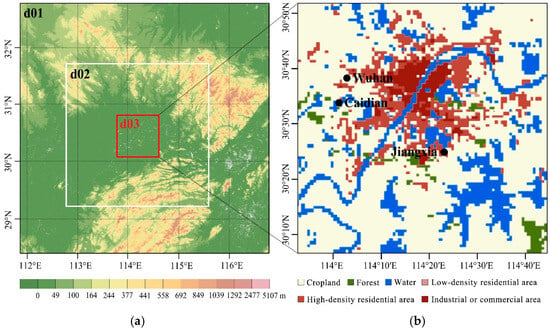
Figure 3.
(a) Configuration of the three-level nested domains for the WRF model; (b) Land-use map with impervious surfaces divided into three categories: low-density residential area, high-density residential area, and industrial or commercial area. Black dots represent the locations of national weather stations, including Jiangxia (30°20′34′′ N, 114°20′06′′ E), Caidian (30°31′24′′ N, 114°00′23′′ E), and Wuhan (30°35′52′′ N, 114°03′02′′ E).
The physical parameterization schemes were as follows: (1) the RRTM scheme for shortwave and longwave radiation [29]; (2) the WSM6 scheme for microphysics [30]; (3) the Kain-Fritsch convective scheme only for the horizontal grid spacing of 9 km [31]; (4) the Noah scheme for land surface processes over natural surfaces [32]; (5) the single-layer urban canopy model (UCM) for the urban surface process [33]; and (6) the MJY scheme for boundary layer parameterization [34]. To accurately reflect the thermal and dynamic characteristics of lake-atmosphere energy exchange in shallow lakes, the Community Land Model 4.5 (CLM4.5) was coupled with the Noah scheme [25,35]. The lake depth was set to 3 m, according to the average depth of shallow lakes in Wuhan [36].
Impervious surfaces were further divided into three categories according to the ratio of impervious surfaces to the total land use (Figure 3): low-density residential areas (impervious surface ratio: 20–49%), high-density residential areas (impervious surface ratio: 50–79%), and industrial or commercial areas (impervious surface ratio: 80–100%). The input parameters (building height, building width, road width, etc.) of the UCM module were obtained from documents provided by the Wuhan Municipal Planning Bureau (as detailed in Table 1) (http://zrzyhgh.wuhan.gov.cn/). Anthropogenic heat emissions were calculated using energy consumption data from the Wuhan Statistical Yearbook of 2022 (https://tjj.wuhan.gov.cn/tjfw/tjnj/202301/t20230112_2130992.shtml (accessed on 25 May 2025)).

Table 1.
Values of urban parameters and anthropogenic heat intensity used in the single-layer urban canopy model.
- (2)
- Meteorological condition and model evaluation
The 3-hourly ERA5 operational global analysis data obtained from the European Center for Medium-Range Weather Forecasts (ECMWF) were used as the initial boundary meteorological conditions to drive the model. A 3-day simulation was conducted, starting from 00:00 local standard time (LST) on August 1 and ending at 00:00 LST on August 4, 2022, with the initial 48 h allocated for a spin-up. Throughout this period, observational data from three national observation stations within the d03 simulation area recorded an average daily maximum air temperature of 37.3 °C and an average daily air temperature of 32.5 °C. The southeast wind was dominant, with an average wind speed of 1.17 m/s, which is consistent with the prevailing wind direction during summertime in Wuhan. The analysis of the 500 hPa geopotential height field (Figure 4a) and sea level pressure field (Figure 4b) on August 1 revealed that Wuhan was controlled by a high-pressure system, resulting in generally weak background wind conditions (with similar characteristics for both fields during the three days).
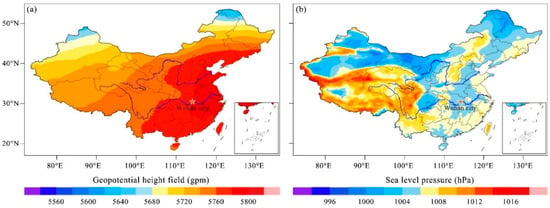
Figure 4.
(a) 500 hPa geopotential height field (units: gpm); (b) sea level pressure field (units: hPa) at 08:00 LST on 1 August 2022.
To evaluate the performance of the WRF model, we compared the simulated hourly 2-m air temperature, 10-m wind speed, and wind direction with observations from three national observation stations within domain 03 (Figure 3b). These observations were provided by the Wuhan Meteorological Bureau and encompassed complete hourly data for the entire simulation period. The model accuracy was evaluated using three indices: bias (BIAS), mean absolute error (MAE), and root mean squared error (RMSE).
where N denotes the number of simulated hours (24 h), Si the simulations at time i, and Oi the observations at time i.
The results revealed that the model accurately captured the diurnal variations in air temperature, with average BIAS, MAE, and RMSE values of 0.112 °C, 0.865 °C, and 0.960 °C, respectively, across the three national observation stations (Figure 5(a1,b1,c1)). The fit between the simulated and observed wind speed and direction curves was not as good as that of the air temperature (Figure 5(a2,b2,c2)), likely due to the complexity of urban surface roughness. The model yielded a BIAS of 0.398 m/s, MAE of 0.465 m/s, and RMSE of 0.551 m/s for wind speed, while for wind direction, the corresponding values were −1.557°, 10.418°, and 9.141°. These performance metrics for wind speed and direction were favorable compared to those of recent studies [37,38]. Overall, the WRF model employed in this study effectively captured the summer thermal patterns and wind distribution characteristics in Wuhan.
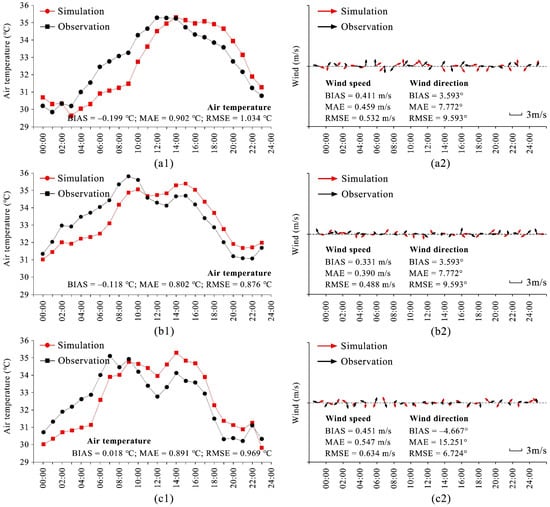
Figure 5.
Comparison between the observed (dark line) and simulated (red line) values for the 2 m air temperature, 10 m wind speed, and wind direction at Jiangxia (a1,a2), Caidian (b1,b2), and Wuhan (c1,c2) stations.
2.2.2. Scenario Design and Modelling
Using the simulation of the 2022 land use conditions (U2022) as the control experiment, we selected the years 1980 (U1980), 2000 (U2000), and 2010 (U2010) as comparative scenarios exhibiting significant differences in the spatial distribution of built-up areas over the past four decades (Figure 6). To depict land use changes over the years, we employed the 30-m resolution land use data for 1980, 2000, and 2010, provided by the Chinese Academy of Sciences, to extract the spatial extent of built-up areas. Given that the sizes of lakes have changed over the years, this study focused specifically on the impact of urban expansion on LBF penetration. Therefore, only built-up areas were modified in each scenario experiment and replaced with the corresponding spatial extents in different years to generate the U1980, U2000, and U2010 configurations. All other surface characteristics, such as lake size and vegetation cover, remained unchanged throughout the control and scenario experiments. Due to the unavailability of urban morphological information for 1980, 2000, and 2010, all built-up areas in both the control and scenario experiments were represented as high-density residential areas, and the urban canopy parameters were configured in accordance with the specifications outlined in Table 1.
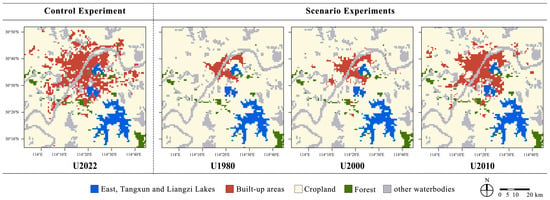
Figure 6.
Land use conditions under the control experiment of U2022 and scenario experiments of U1980, U2000, and U2010.
2.2.3. Analytical Methods
- Calculation of impervious surface ratio (ISR) along lakesides: East and Tangxun Lakes shifted from the periphery to within urban areas, while Liangzi Lake remained on the periphery of built-up areas. Consequently, we calculated the ISR distribution within 3 km buffer zones in each 30° sector around East and Tangxun Lakes to analyze the evolution of urban-lake spatial patterns between 1980 and 2022. The selection of 3 km buffer zones aimed to encompass a broader extent of built-up areas along the lakesides, considering the absence of other lakes.
- Identification of LBF locations: The location of LBFs was evaluated by the high vertical velocity zone at an altitude of 200 m above sea level, following the method proposed by relevant studies [39] and considering the terrain elevation within Wuhan’s urban areas. Dividing the lakesides of the three lakes into 12 sectors with 30° intervals, we calculated the LBF penetration distances for each 30° sector of East, Tangxun, and Liangzi Lake during their strongest development period (11:00 LST–15:00 LST) under control and scenario experiments.
- LBF penetration model: We developed a multivariable linear regression model to examine the influence of thermal, aerodynamic, and background wind factors on LBF penetration, which was evaluated according to the hourly penetration distances of LBFs between 11:00 and 15:00 LST. The evolution of urban lake spatial patterns has two primary impacts on the penetration distances of LBFs: thermal and aerodynamic effects [40,41]. The former was measured using three factors: lake-land surface temperature differences (LSTD), urban heat island intensity (UHII), and the distance between the UHII-weighted center and the lake center (DUL). The latter is related to the roughness characteristics of lake-land surface roughness differences (LSRD). The 10-m wind speed and wind direction were used to represent the background wind field derived from numerical simulations for different scenarios. The calculation methods for these factors are presented in Table 2. In the LBF penetration model, all factors were normalized, and the R2 value was used to assess how well the developed model explained the LBF penetration distances. Additionally, p-values were calculated to evaluate the statistical significance of coefficients.
 Table 2. Definitions of the impact factors in the LBF penetration model.
Table 2. Definitions of the impact factors in the LBF penetration model.
The urban heat island intensity (UHII) was calculated based on the hourly surface temperature differences between impervious and cropland surfaces in southern areas of the Yangtze River. This calculation method was chosen due to the notable differences in meteorological characteristics between the river’s northern and southern areas [42,43], and all three lakes are situated in the river’s southern regions. Croplands were selected to calculate the suburban surface temperature rather than water bodies or mountains because the daytime surface temperature of water bodies and mountains is typically lower than that of croplands, thus leading to an overestimation of the UHII. Lake-land surface roughness differences (LSTD) were used to quantify the influence of land-use changes resulting from urban expansion on surface roughness. This illustrates how the alternation in surface roughness around lakes affects LBF penetration via frictional effects on airflow. In densely built-up areas, the surface roughness usually exceeds 2 m in height [44]. In this study, considering the horizontal uniformity of built-up areas, we set 2 m as the surface roughness for built-up areas while assigning cropland and water surface roughness values of 0.2 m and 0.05 m, respectively [13].
3. Results
3.1. Evolution of Urban-Lake Spatial Patterns
Figure 7a shows the spatial distribution of the ISR in different directions around East and Tangxun Lakes from 1980 to 2022. Subsequently, we summarized the evolution of the spatial locations and distances between built-up areas and lakes (Figure 7b). Over time, the spatial relationship between East Lake and the surrounding built-up areas has shifted from being “alongside the lake” to being “integrated within the urban fabric”. Since 1980, the southwestern area alongside East Lake has been connected with urban fabrics, while certain built-up areas have emerged on the northern lakesides but are distant from lakeshores. Between 2000 and 2010, the built-up areas in the northern areas gradually expanded toward the lakeshore without forming a close connection with it. By 2022, East Lake was enveloped by urban development.
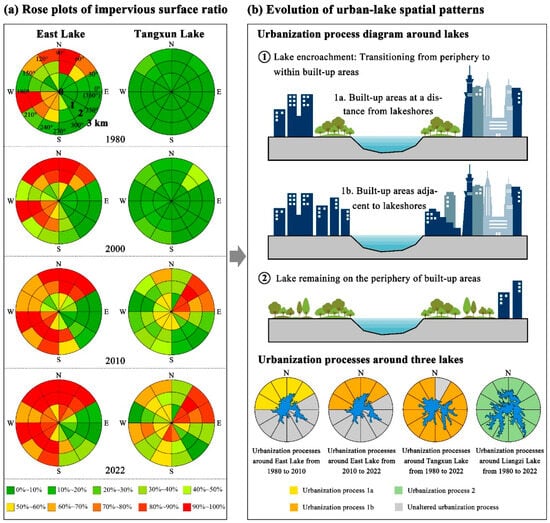
Figure 7.
(a) Rose plots of the impervious surface ratio (ISR) in the 3 km buffer zone around East and Tangxun Lakes with 30° intervals between 1980 and 2022; (b) Evolution of the spatial location and distances between built-up areas and lakeshores in each 30° sector for East, Tangxun, and Liangzi Lakes between 1980 and 2022.
Similarly, Tangxun Lake has gradually been encroached upon by urban expansion over the past four decades, transitioning from being on the periphery of the built environment to being encircled by urban structures. Between 1980 and 2000, Tangxun Lake remained on the periphery, predominantly surrounded by croplands. By 2010, urban structures began connecting with the northeastern lakesides, and by 2022, Tangxun Lake was fully integrated into the urban fabric. In general, the evolution of urban lake spatial patterns involves two primary processes: the transition from periphery to within built-up areas (encompassing built-up areas either adjacent or at a distance from lakeshores) and the maintenance of a peripheral position in relation to built-up areas.
3.2. Impact of Urban-Lake Spatial Patterns on LBF Penetration
Figure 8 shows the spatial distribution of LBFs in East, Tangxun, and Liangzi Lakes during their peak development period (11:00–15:00 LST) under the U1980, U2000, U2010, and U2022 experiments. Overall, LBFs formed earlier on the upwind lakesides than on the downwind lakesides, and the penetration distances of LBFs were greater on the downwind lakesides than on the upwind lakesides. As built-up areas expanded toward the lakeshores, the lakesides underwent a transformation from their previous state, primarily as croplands where LBFs were absent, to their current state as built-up areas marked by the emergence of LBFs.
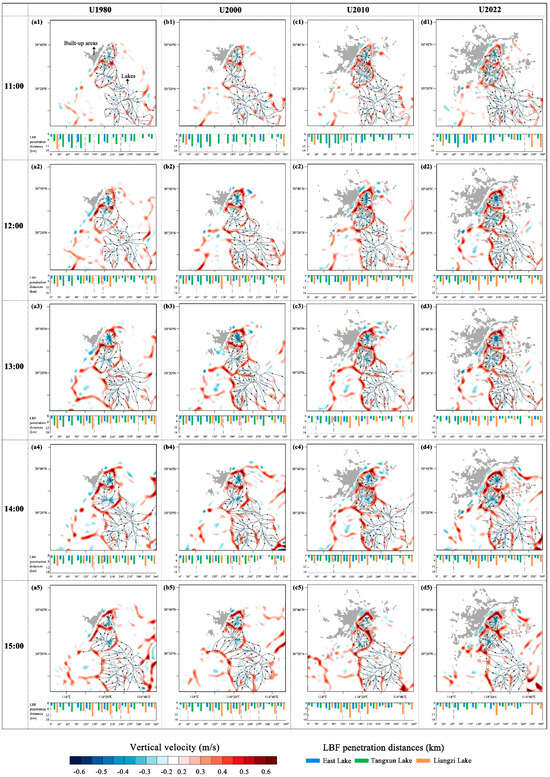
Figure 8.
Vertical velocity contours and wind streamlines, along with the penetration distances of LBFs, for East, Tangxun, and Liangzi Lakes at a height of 200 m above sea level between 11:00 and 15:00 LST under the U1980, U2000, U2010, and U2022 scenarios.
From 1980 to 2022, the southeastern lakesides (180° to 270°) around East Lake connected with built-up areas consistently observed LBFs in this region between 11:00 LST and 15:00 LST (Figure 8(a1–a5,b1–b5,c1–c5,d1–d5)). However, there were no significant changes in the LBF penetration distances due to minimal alterations in the spatial connection between built-up areas and southeastern lakeshores over the decades. Even though the built-up areas northeastward (30° to 90°) were distant from the lakeshore of East Lake, LBFs also appeared in this area. Between 1980 and 2022, the penetration distances of LBFs in the northeast (30° to 90°) and northwest (90° to 180°) initially increased and later decreased, with the turning point for the decrease occurring in 2010 (Figure 8(a1–a5,b1–b5,c1–c5,d1–d5)). The average LBF penetration distances followed this ranking in the northeast: 2010 (4.4 km) > 2000 (4.1 km) > 1980 (3.9 km) ≈ 2022 (3.9 km). In the northwest, the order was: 2010 (5.9 km) > 2000 (5.2 km) > 1980 (5.0 km) > 2022 (4.6 km).
Between 2010 and 2022, LBFs appeared in the northeast (0° to 60°) of Tangxun Lake at 11:00 LST (Figure 8(c1,d1)), in contrast to the period from 1980 to 2000, when they were absent (Figure 8(a1,b1)). This change can be attributed to the transformation of land use on lakesides from croplands to built-up areas. With the southwest (180° to 270°) of Tangxun Lake closely connected to built-up areas, the average penetration distances of LBFs notably decreased by 3.2 km in both 2010 and 2022 compared with 1980 and 2000. By 2022, Tangxun Lake generated LBFs on all its lakesides, forming a ring of LBFs at 13:00 LST (Figure 8(d3)) due to complete encirclement by built-up areas. Liangzi Lake, characterized by its complex natural shape with numerous bays and harbors, consistently displayed a convergence zone of LBFs only on its downwind lakesides, while the upwind lakesides showed scattered occurrences of LBFs.
There were interaction effects between the LBFs from the southeast of Tangxun Lake and the northwest of Liangzi Lake due to their proximity. From 1980 to 2000, the distribution characteristics of LBFs in this region were similar (Figure 8(a1–a5,b1–b5)). At 11:00 LST, LBFs appeared near Tangxun Lake, with no occurrence of LBFs in any downwind areas of Liangzi Lake (Figure 8(a1,b1)). This indicates that the LBF was independently boosted by Tangxun Lake and not influenced by Liangzi Lake. Between 12:00 and 14:00 LST, the average penetration distance of this LBF away from Tangxun Lake’s shores gradually increased from 3.5 km to 6.3 km (Figure 8(a2–a4,b2–b4)), accompanied by the appearance of LBFs in the downwind areas of Liangzi Lake. This indicates that the location of this LBF was influenced by the combined effects of Tangxun and Liangzi Lakes, with Tangxun Lake primarily affecting the location of this LBF. By 15:00 LST, the average distance between the LBF and Tangxun Lake’s shores decreased to 3.3 km (Figure 8(a5,b5)), suggesting that Liangzi Lake had a predominant influence on the location of the LBF. Between 2010 and 2022, the LBF remained near the shores of Tangxun Lakedue to the consistent primary impact from Liangzi Lake (Figure 8(c1–c5,d1–d5)). However, there have been no notable alterations in the LBF penetration distances along the southwest of Liangzi Lake over the past four decades.
3.3. Factors Affecting LBF Penetration Distances
3.3.1. Lake Encroachment: Transitioning from Periphery to Within Built-Up Areas
The impacts of thermal, aerodynamic, and background wind factors on LBF penetration distances are depicted in Figure 5. Multiple linear regression was employed to assess the influence of impact factors (LSTD, LSRD, WD, WS) on the penetration distances of LBFs when lakes have been encroached from the periphery to within built-up areas, encompassing both built-up areas at a distance from lakeshores (Figure 9(a1,a2)) and those adjacent to the lakeshores (Figure 9(b1–b5)). Similar penetration distances of the LBFs were observed in each 30° sector of the same quadrant (Figure 7). Subsequently, separate multivariable linear regression analyses were performed for each quadrant. Lakesides that remained unchanged in spatial relationships with built-up areas were excluded from the investigation of factors impacting LBF penetration distances. Additionally, the LBFs positioned between the southeast of Tangxun Lake and the northwest of Liangzi Lake were predominantly influenced by the interaction among the lakes rather than the thermal and roughness characteristics of the underlying surfaces. Consequently, an analysis of the impact factors on LBF penetration distances in this area was excluded. The results show that the variance inflation factor (VIF) values for all indicators in the regression equations were significantly less than 10, suggesting that multicollinearity was nonexistent [45].
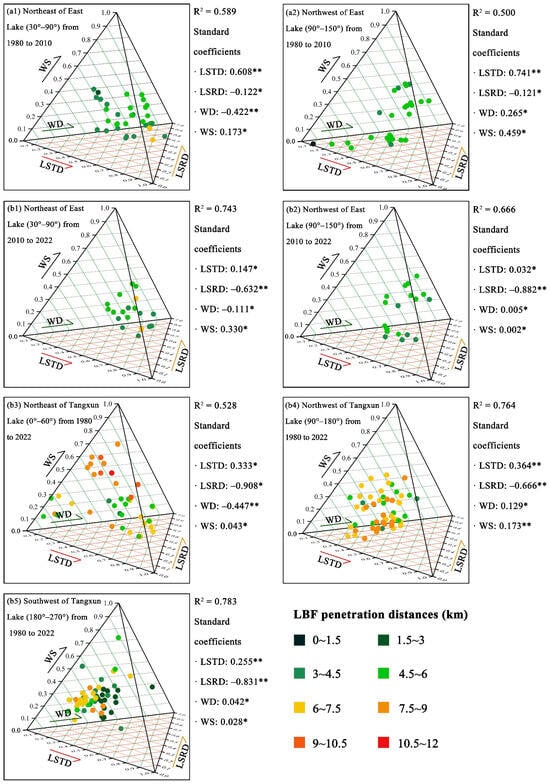
Figure 9.
The impact of lake-land surface temperature differences (LSTD), lake-land surface roughness differences (LSRD), wind speed (WS), and wind direction (WD) on the penetration distances of LBFs as lakes are encroached from the periphery to within built-up areas, including built-up areas at a distance from lakeshores (a1,a2) and built-up areas adjacent to lakeshores (b1–a5). ** and * indicates p < 0.01 level (two-tailed) and p < 0.05 level (two-tailed), respectively.
When lakes were encroached upon from the periphery to within built-up areas, LSTD, LSRD, WD, and WS were the primary factors influencing the penetration distances of LBFs. However, the relative contributions of each factor to the penetration distances of LBFs varied across different distances between built-up areas and lakeshores. Specifically, LSTD was positively correlated with the penetration distance of LBFs, while LSRD was negatively correlated. As built-up areas moved closer to lakeshores without connection, the relative contribution of LSTD (0.608–0.741) was notably higher compared to LSRD (−0.122 to −0.121) (Figure 9(a1,a2)). This indicates that the expansion of built-up areas promotes the infiltration of LBFs due to the dominant influence of thermal factors. Conversely, as built-up areas were closely connected with urban structures, the relative contribution of LSRD (−0.908~−0.632) exceeded that of LSTD (0.032–0.364) (Figure 9(b1–b5)), demonstrating that built-up area expansion inhibited LBF penetration primarily driven by roughness factors. Furthermore, WD showed negative correlations with LBF penetration distances in the upwind lakesides (−0.447 to −0.111) and positive correlations in the downwind lakesides (0.005–0.265), while WS consistently exhibited a positive correlation with LBF penetration distances (0.002–0.459), and the relative contribution of WD and WS was generally smaller than that of LSTD and LSRD. This demonstrates that the background wind field has a slight regulatory effect on LBF penetration.
3.3.2. Lake Remaining on the Periphery of Built-Up Areas
When lakes remain on the periphery of built-up areas, LSTD and LSRD had no significant impact on the penetration distances of LBFs because these factors experienced minimal changes during urban expansion. Instead, the UHII and DUL emerged as the primary thermal factors influencing LBF penetration. Due to the significant increase in penetration distances in the northwest of Liangzi Lake as built-up areas moved closer, we developed a multivariable regression model to investigate how the UHII, DUL, WD, and WS influence the penetration distances of LBFs in this area. The R2 value of the regression equation was 0.761, with standardized coefficients of 0.822 for UHII (p < 0.01), −0.151 (p < 0.05) for DUL, 0.072 for WD (p < 0.05), and 0.031 for WS (p < 0.05) (Figure 10a). This demonstrates a significant positive correlation between the UHII and LBF penetration distances, along with a negative correlation with the DUL. Moreover, the UHI exhibited a comparatively larger contribution to penetration distance than the other factors. Along the cross-section of Liangzi Lake’s LBF entering built-up areas at 13:00 LST (Figure 10(b1–b4)), strong vertical updrafts (about 1.63 m/s) were observed at the intersection between LBFs from Tangxun Lake and Liangzi Lake. Despite inhibition by the LBF from Tangxun Lake, the LBF from Liangzi Lake accelerated toward built-up areas under the U2010 and U2022 experiments (Figure 10(b3,b4)), resulting in greater penetration distances (about 2.2 km) under the U2010 and U2022 experiments compared to other scenarios (Figure 10(b1,b2)). However, once it reached built-up areas, the LBF from Liangzi Lake could not penetrate further into urban areas due to its weakened intensity.
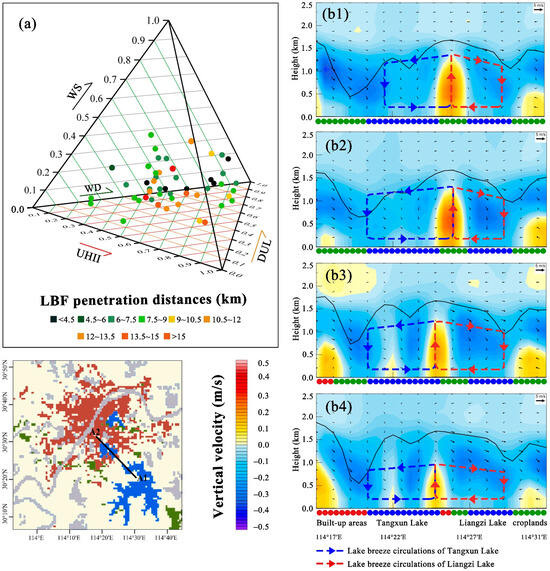
Figure 10.
The impact of urban heat island intensity (UHII), distances between the UHII-weighted center and the lake center (DUL), wind speed (WS), and wind direction (WD) on the penetration distances of LBFs in the northwest of Liangzi Lake (a); Vertical cross-sections of vertical velocity (w, shaded), and vector (uv, w × 5) distributions at 13:00 LST under U1980 (b1), U2000 (b2), U2010 (b3), and U2022 (b4) along line A1–A2. The color coding at the bottom of the figures (b1–b4) represents the land-use category. The solid black lines represent the urban boundary heights along the sections in each scenario.
4. Discussion
4.1. Key Attributes of Urban Thermal and Aerodynamic Effects for LBF Penetration Vary with Urban-Lake Spatial Patterns
This study explored the influence of urban lake spatial pattern evolution in Wuhan between 1980 and 2022 on LBF penetration through thermal and aerodynamic mechanisms. Our sensitivity experiments considered realistic spatio-temporal urbanization processes, providing more urbanization-induced thermal and aerodynamic scenarios than previous experiments using an unrealistic “no city” scenario or a rapid and continuous expansion of built-up areas [46,47]. The results show that LBFs are linked to LBCs and cannot exist independently (Figure 11), in contrast to SBFs, which can exist independently from sea breeze circulations extending continuously to the inland built-up areas [14,48]. This distinction between LBF’s dependence on LBCs and SBF’s independent extension to inland built-up areas delineates a crucial feature of local thermal circulations observed in these relatively smaller lakes within urban areas.
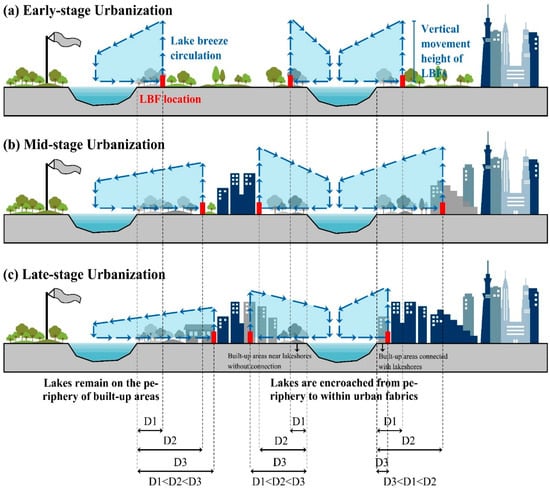
Figure 11.
Diagram illustrating the influence of urban expansion on LBF penetration across various urban-lake spatial patterns during the early stage (a), mid-stage (b), and late stage (c) of urbanization.
When lakes are encroached upon from the periphery to within urban fabrics, LSTD and LSRD emerge as the predominant urban thermal and roughness factors on the penetration distances of LBFs. There was a positive correlation between LSTD and the penetration distance of the LBFs, while LSRD was negatively correlated with it. However, the relative contributions of the LSTD and LSRD to LBF penetration distances vary with the distances between built-up areas and lakeshores. Specifically, as built-up areas expand closer to lakeshores without connection, their expansion promotes the natural infiltration of LBFs (Figure 11a,b), primarily driven by urban thermal factors, where the relative contribution of LSTD significantly exceeds that of LSRD. Conversely, as built-up areas are closely connected to lakeshores, their expansion inhibits the penetration of LBFs due to the drag effects of urban areas, where the relative contribution of LSRD is greater than that of LSTD (Figure 11b,c). Furthermore, background wind fields had a slight regulatory effect on the penetration distances of the LBFs. Wind speed and direction contribute to the extension of LBF penetration on downwind lakesides. However, on the upwind lakesides, although the background wind speed continued to facilitate LBF penetration, the wind direction acted as an inhibiting factor. Similarly, previous research suggests that the downwind extension of LBFs in the lakes’ downwind regions leads to extensive cooling in those areas [49,50,51].
When lakes remain on the periphery of built-up areas, urban aerodynamic factors have no significant impact on LBF penetration. Urban thermal factors take precedence in influencing LBF penetration, where the UHII and UDL replace the LSTD as the primary factors affecting LBF penetration distances. Increased UHII prompted LBFs from suburban lakes to initiate earlier and accelerate movement toward urban areas along the line connecting the UHII-weighted center and lake center, with no notable changes in LBF penetration distances in other directions. This is consistent with previous findings showing that the UHI contributes to heightened temperature differences between the lake and built-up areas, amplifying LBCs and extending LBF penetration distances [22,46]. However, once it reached urban boundaries, the weakened LBF intensity restricted further penetration into the inner urban areas. This differs from the findings on the interaction between SBFs and urbanization, where the inability of SBFs to reach inner urban areas is attributed to the inhibiting effects of UHICs when the city is located far from coastlines [21,52,53]. Overall, LBFs originating from suburban lakes encounter limitations in infiltrating inner urban areas, regardless of potential obstruction from UHICs, as their intensities diminish upon reaching urban boundaries.
4.2. Adaptive Strategies for Urban Growth Boundaries (UGB) Based on LBF-Urbanization Interaction
The penetration of LBFs into urban areas, resulting in extensive cooling within urban environments, represents a crucial ecosystem service that can be harnessed for planning cooler cities. Based on the effects of LBF-urbanization interaction, we propose adaptive strategies for UGBs to limit inappropriate outward metropolitan expansion targeted at facilitating the natural infiltration of LBFs, as described below (Figure 12).
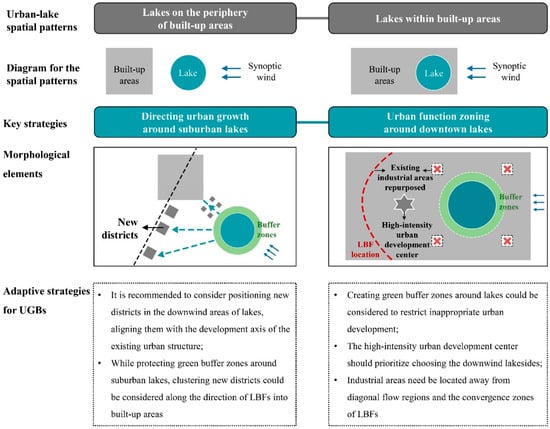
Figure 12.
Adaptive strategies for urban growth boundaries (UGB) to facilitate the natural infiltration of LBFs into urban areas.
- Directing urban growth around suburban lakes: For lakes consistently situated outside urbanized areas, the heightened UHII resulting from urban expansion only extends LBF penetration distances into urban areas while causing minimal changes in other downwind areas. Therefore, it is recommended that new districts be positioned in these downwind areas to enhance the lake-land thermal contrast, thereby expanding the impact range of LBFs. As LBFs from suburban lakes approach UGBs, their reduced intensity restricts further penetration into the inner urban areas. Therefore, to protect the green buffer zones around suburban lakes, clustering new districts with high building ventilation, low building density, and low building height should be considered to amplify the lake-land thermal contrast and manage the inhibitory effects of increased surface roughness on LBF penetration.
- Urban function zoning around downtown lakes: In the era of global urban development trends transitioning toward the establishment of metropolitan regions [54,55], smaller lakes (below 50 km2) connected with urban fabrics frequently evolve into downtown lakes within an urban conurbation. This transformation occurs because lakes offer efficient cooling benefits and serve as valuable landscape resources for adjacent urban zones, consequently prompting increased urban expansion around lakes. As the close proximity between built-up areas and lakeshores inhibits the penetration of LBFs, creating green buffer zones around lakes could restrict inappropriate urban development. For high-intensity urban development centers, prioritizing the downwind lakesides is crucial due to the greater penetration distances of LBFs. Additionally, when selecting locations for industrial zones that generate significant anthropogenic heat and air pollution, it is essential to consider the influence of diagonal flows and the position of LBFs. Therefore, it is recommended that industrial zones be situated away from diagonal flow regions and LBF convergence zones to reduce heat accumulation and airflow hindrance. As a result, the existing industrial zones within these areas must be repurposed.
4.3. Limitations and Future Research
This study examined the response of LBFs to the evolution of urban-lake spatial patterns through urbanization-induced thermal and aerodynamic effects under high-temperature, weak-wind weather conditions during prevailing summer wind conditions over the past four decades in Wuhan. While the analysis centered on prevailing conditions, LBF characteristics were also influenced by synoptic wind direction and wind speed. Future research should further explore the driving factors of LBFs under non-prevailing wind directions and across a wider range of wind speed conditions. Moreover, this study primarily focused on the impact of built-up area expansion on the climatic effects of lakes. Future research should examine the influence of lake shrinkage on urban thermal stress, particularly under extreme scenarios in which lakes are entirely encroached upon by urban development. Additionally, our findings revealed that urban expansion toward lakes accelerated LBF formation and their spread into urban environments, leading to heightened cooling effects along the lakesides. However, the conversion of non-built-up areas to urban structures alongside lakes typically raises local temperatures [56,57]. Future research should explore the balance between the amplified cooling effects of lakes resulting from urban expansion around lakesides and the concurrent increase in local temperatures within these urbanized areas. Such investigations should aim to formulate development control guidelines for lakeside areas to maximize the cooling benefits of lakes.
5. Conclusions
This study examined how urban lake spatial patterns shaped by uneven urbanization have influenced the penetration of LBFs through thermal and aerodynamic mechanisms over the past four decades in Wuhan. Using the WRF-Lake model, we conducted sensitivity experiments under high-temperature and weak-wind conditions. The main conclusions of this study are summarized below.
- For lakes situated within urban fabrics, the transition from non-built-up areas to urban structures alongside the lake resulted in the earlier formation and stronger upward motion of LBFs. However, the extent of LBF penetration depended on the distance between built-up areas and lakeshores. As built-up areas expanded toward lakeshores without connection, their expansion enhanced LBF penetration, with the positive benefits of LSTD (0.608–0.741) outweighing the negative impacts of LSRD (−0.122 to −0.121). Conversely, when urban areas transitioned from being distant or nearby to becoming connected with lakeshores, their expansion limited LBF penetration due to LSRD (−0.908 to −0.632) exhibiting more inhibiting effects compared to the promotion of LSTD (0.032–0.364).
- For lakes remained on the periphery of built-up areas, the UHII and movement of the UHII-weighted centers emerged as the primary factors influencing the infiltration of LBFs. The increased UHII, along with the UHII-weighted center shifting toward suburban lakes, led to an earlier LBF entry into built-up areas. This also accelerated the spread of LBFs along the path between the UHII-weighted center and the lake center. However, the penetration distances of the LBFs remained unchanged in the other directions. Once the LBFs approached the edge of the urban areas, their weakening intensities limited their further penetration into the inner city.
Based on these findings, a series of adaptive strategies for UGBs were proposed that highlight the importance of proper delineation and protection of green buffer zones around lakes, as well as ensuring the appropriate distribution of air evacuation pathways in both new districts and existing built-up areas. These strategies aim to guide urban growth and renewal, making full use of LBFs to enhance urban ventilation naturally.
Author Contributions
Y.C.: Conceptualization, Data curation, Formal analysis, Methodology, Software, Validation, Visualizations, Writing—original draft and revisions; W.Z.: Writing—review and editing; X.N.: Writing—review and editing; X.Z.: Writing—review and editing; C.W.: Writing—review and editing; B.R.: Data curation, Formal analysis, Methodology, Software, Validation, Visualizations Y.Z.: Investigation, Methodology, Software, Validation, Visualization; C.L.: Investigation, Methodology, Software, Validation, Visualization; X.W.: Resources; C.Y.: Resources. All authors have read and agreed to the published version of the manuscript.
Funding
This research received no external funding.
Data Availability Statement
The original contributions presented in the study are included in the article, further inquiries can be directed to the corresponding author.
Conflicts of Interest
The authors declare no conflicts of interest.
References
- Ebi, K.L.; Capon, A.; Berry, P.; Broderick, C.; de Dear, R.; Havenith, G.; Honda, Y.; Kovats, R.S.; Ma, W.; Malik, A.; et al. Hot weather and heat extremes: Health risks. Lancet 2021, 398, 698–708. [Google Scholar] [CrossRef] [PubMed]
- Santamouris, M. Analyzing the heat island magnitude and characteristics in one hundred Asian and Australian cities and regions. Sci. Total Environ. 2015, 512–513, 582–598. [Google Scholar] [CrossRef]
- Campbell, I.; Sachar, S.; Meisel, J.; Nanavatty, R.; United Nations Environment Programme. Beating the Heat: A Sustainable Cooling Handbook for Cities; UNEP: Nairobi, Kenya, 2021. [Google Scholar]
- C40 Cities Climate Leadership Group & Ramboll. Urban Cooling Toolbox. 2021. Available online: https://www.c40knowledgehub.org/s/article/Urban-Cooling-Toolbox (accessed on 1 January 2022).
- Cheng, Y.; Shen, L.; Teng, M.; Liu, H.; Cheng, W.; Zhang, B.; Wu, C. How to use lake breeze circulations to improve urban natural ventilation: A case study in a typical inland multi-lake megacity. Landsc. Urban Plan. 2023, 230, 104628. [Google Scholar] [CrossRef]
- Guo, F.; Zhang, H.; Fan, Y.; Zhu, P.; Wang, S.; Lu, X.; Jin, Y. Detection and evaluation of a ventilation path in a mountainous city for a sea breeze: The case of Dalian. Build. Environ. 2018, 145, 177–195. [Google Scholar] [CrossRef]
- Ng, E. Policies and technical guidelines for urban planning of high-density cities—Air ventilation assessment (AVA) of Hong Kong. Build. Environ. 2009, 44, 1478–1488. [Google Scholar] [CrossRef]
- Zhou, X.; Zhang, S.; Zhu, D. Impact of Urban Water Networks on Microclimate and PM2.5 Distribution in Downtown Areas: A Case Study of Wuhan. Build. Environ. 2021, 203, 108073. [Google Scholar] [CrossRef]
- Laird, N.F.; Kristovich, D.A.R.; Liang, X.-Z.; Arritt, R.W.; Labas, K. Lake Michigan Lake Breezes: Climatology, Local Forcing, and Synoptic Environment. J. Appl. Meteorol. Climatol. 2001, 40, 409–424. [Google Scholar] [CrossRef]
- Sills, D.M.L.; Brook, J.R.; Levy, I.; Makar, P.A.; Zhang, J.; Taylor, P.A. Lake breezes in the southern Great Lakes region and their influence during BAQS-Met 2007. Atmos. Chem. Phys. 2011, 11, 7955–7973. [Google Scholar] [CrossRef]
- You, C.; Fung, J.C.H. Characteristics of the sea-breeze circulation in the pearl river delta region and its dynamical diagnosis. J. Appl. Meteorol. Climatol. 2019, 58, 741–755. [Google Scholar] [CrossRef]
- Samuelsson, P.; Tjernström, M. Mesoscale flow modification induced by land-lake surface temperature and roughness differences. J. Geophys. Res. Atmos. 2001, 106, 12419–12435. [Google Scholar] [CrossRef]
- Shen, L.; Sun, J.; Yuan, R. Idealized large-eddy simulation study of interaction between urban heat island and sea breeze circulations. Atmos. Res. 2018, 214, 338–347. [Google Scholar] [CrossRef]
- Wang, W.; Shu, J. Impacts of spatiotemporally uneven urbanization on sea breeze fronts in a mega-river delta. Landsc. Urban Plan. 2022, 218, 104287. [Google Scholar] [CrossRef]
- Santamouris, M. On the energy impact of urban heat island and global warming on buildings. Energy Build. 2014, 82, 100–113. [Google Scholar] [CrossRef]
- Allegrini, J.; Viktor, D.; Carmeliet, J. Influence of morphologies on the microclimate in urban neighbourhoods. J. Wind Eng. Ind. Aerodyn. 2015, 144, 108–117. [Google Scholar] [CrossRef]
- Bartesaghi-Koc, C.; Osmond, P.; Peters, A. Innovative use of spatial regression models to predict the effects of green infrastructure on land surface temperatures. Energy Build. 2022, 254, 111564. [Google Scholar] [CrossRef]
- Khan, S.M.; Simpson, R.W. Effect of a heat island on the meteorology of a complex urban airshed. Bound.-Layer Meteorol. 2001, 100, 487–506. [Google Scholar] [CrossRef]
- Ribeiro, F.; Oliveira, A.; Soares, J.; Miranda, R.; Barlage, M.; Chen, F. Effect of sea breeze propagation on the urban boundary layer of the metropolitan region of Sao Paulo, Brazil. Atmos. Res. 2018, 214, 174–188. [Google Scholar] [CrossRef]
- Dandou, A.; Tombrou, M.; Soulakellis, N. The influence of the City of Athens on the evolution of the sea-breeze front. Bound.-Layer Meteorol. 2009, 131, 35–51. [Google Scholar] [CrossRef]
- Ohashi, Y.; Kida, H. Local circulations developed in the vicinity of both coastal and inland urban areas: A numerical study with a mesoscale atmospheric model. J. Appl. Meteorol. 2002, 41, 30–45. [Google Scholar] [CrossRef]
- Yang, J.; Liu, H.; Fei, S.; Zhang, N.; Jiang, W. The impact of urbanization on the urban heat island in Suzhou under the influence of Taihu lake-land breeze. J. Meteorol. Sci. 2013, 33, 473–484. [Google Scholar] [CrossRef]
- Deng, B.; Liu, S.; Xiao, W.; Wang, W.; Jiming, J. Evaluation of the CLM4 Lake Model at a Large and Shallow Freshwater Lake. J. Hydrometeorol. 2012, 14, 636–649. [Google Scholar] [CrossRef]
- Gu, H.; Jin, J.; Wu, Y.; Ek, M.B.; Subin, Z.M. Calibration and validation of lake surface temperature simulations with the coupled WRF-lake model. Clim. Change 2015, 129, 471–483. [Google Scholar] [CrossRef]
- Subin, Z.M.; Riley, W.J.; Mironov, D. An improved lake model for climate simulations: Model structure, evaluation, and sensitivity analyses in CESM1. J. Adv. Model. Earth Syst. 2012, 4, 1–27. [Google Scholar] [CrossRef]
- Cheng, Y.; Bartesaghi-Koc, C.; Tian, Y.; Shen, L.; Teng, M.; Liu, H.; Xiao, Z.; Zhang, B.; Wu, C. Where and how to cool through blue infrastructure? Large lake groups to ameliorate urban overheating in a typical inland multi-lake megacity. Sustain. Cities Soc. 2023, 98, 104869. [Google Scholar] [CrossRef]
- Zhu, D.; Zhou, X.; Cheng, W. Water effects on urban heat islands in summer using WRF-UCM with gridded urban canopy parameters—A case study of Wuhan. Build. Environ. 2022, 225, 109528. [Google Scholar] [CrossRef]
- Wuhan Bureau of Statistics. Wuhan Statistical Yearbook; Chinese Statistics Press: Beijing, China, 2023. (In Chinese) [Google Scholar]
- Mlawer, E.J.; Taubman, S.J.; Brown, P.D.; Iacono, M.J.; Clough, S.A. Radiative transfer for inhomogeneous atmospheres: RRTM, a validated correlated-k model for the longwave. J. Geophys. Res. Atmos. 1997, 102, 16663–16682. [Google Scholar] [CrossRef]
- Hong, S.-Y.; Lim, K.-S.; Kim, J.-H.; Lim, J.-O.; Dudhia, J. The WRF Single-Moment 6-Class Microphysics Scheme (WSM6). Asia-Pac. J. Atmos. Sci. 2006, 42, 129–151. [Google Scholar]
- Kain, J.S. The Kain-Fritsch Convective Parameterization: An Update. J. Appl. Meteorol. 2004, 43, 170–181. [Google Scholar] [CrossRef]
- Chen, F.; Dudhia, J. Coupling an advanced land surface-hydrology model with the Penn State-NCAR MM5 modeling system. Part I: Model implementation and sensitivity. Mon. Weather Rev. 2001, 129, 569–585. [Google Scholar] [CrossRef]
- Kusaka, H.; Kondo, H.; Kikegawa, Y.; Kimura, F. A simple single-layer urban canopy model for atmospheric models: Comparison with multi-layer and slab models. Bound.-Layer Meteorol. 2001, 101, 329–358. [Google Scholar] [CrossRef]
- Janjic, Z.I. The Step-Mountain Coordinate: Physical Package. Mon. Weather Rev. 1990, 118, 1429–1443. [Google Scholar] [CrossRef]
- Oleson, K.W.; Bonan, G.B.; Feddema, J.J.; Vertenstein, M.; Kluzek, E. Technical Description of an Urban Parameterization for the Community Land Model (CLMU). 2010. Available online: https://opensky.ucar.edu/islandora/object/%3A3804 (accessed on 20 May 2022).
- Wuhan Water Affair Bureau. Records of Lakes in Wuhan; Changjiang Press: Wuhan, China, 2014. [Google Scholar]
- Deng, X.; Cao, Q.; Wang, L.; Wang, W.; Wang, S.; Wang, S.; Wang, L. Characterizing urban densification and quantifying its effects on urban thermal environments and human thermal comfort. Landsc. Urban Plan. 2023, 237, 104803. [Google Scholar] [CrossRef]
- Zheng, Z.; Lin, X.; Chen, L.; Yan, C.; Sun, T. Effects of urbanization and topography on thermal comfort during a heat wave event: A case study of Fuzhou, China. Sustain. Cities Soc. 2024, 102, 105233. [Google Scholar] [CrossRef]
- Miao, Y.; Liu, S.; Zheng, Y.; Wang, S.; Chen, B. Numerical study of the effects of topography and urbanization on the local atmospheric circulations over the Beijing-Tianjin-Hebei, China. Adv. Meteorol. 2015, 2015, 397070. [Google Scholar] [CrossRef]
- Boybeyi, Z.; Raman, S. A Three-Dimensional Numerical Sensitivity Study of Mesoscale Circulations Induced by Circular Lakes. Meteorol. Atmos. Phys. 1992, 49, 19–41. [Google Scholar] [CrossRef]
- Crosman, E.T.; Horel, J.D. Sea and Lake Breezes: A Review of Numerical Studies. Bound.-Layer Meteorol. 2010, 137, 1–29. [Google Scholar] [CrossRef]
- Chen, X.; Zhang, S.; Tian, Z.; Luo, Y.; Deng, J.; Fan, J. Differences in urban heat island and its driving factors between central and new urban areas of Wuhan, China. Environ. Sci. Pollut. Res. 2023, 30, 58362–58377. [Google Scholar] [CrossRef]
- Yu, S.; Ren, Z.; Shan, X.; Deng, Q.; Zhou, Z. Seasonal different effects of land cover on urban heat island in Wuhan’s metropolitan area. Urban Clim. 2023, 49, 101547. [Google Scholar] [CrossRef]
- Grimmond, C.; Oke, T. Turbulent heat fluxes in urban areas: Observations and a local-scale urban meteorological parameterization scheme (LUMPS). J. Appl. Meteorol. 2002, 41, 792–810. [Google Scholar] [CrossRef]
- Shrestha, N. Detecting multicollinearity in regression analysis. Am. J. Appl. Math. Stat. 2020, 8, 39–42. [Google Scholar] [CrossRef]
- Li, W.; Liu, H.; Zhou, X.; Qin, Y. Analysis of the influence of Taihu Lake and the urban heat islands on the local circulation in the Yangtze Delta. Sci. China Ser. D Earth Sci. 2003, 46, 405–415. [Google Scholar] [CrossRef]
- Li, M.; Mao, Z.; Song, Y.; Liu, M.; Huang, X. Impacts of the Decadal Urbanization on Thermally Induced Circulations in Eastern China. J. Appl. Meteorol. Climatol. 2015, 54, 259–282. [Google Scholar] [CrossRef]
- Ryu, Y.H.; Baik, J.J. Daytime local circulations and their interactions in the Seoul metropolitan area. J. Appl. Meteorol. Climatol. 2013, 52, 784–801. [Google Scholar] [CrossRef]
- Cosgrove, A.; Berkelhammer, M. Downwind footprint of an urban heat island on air and lake temperatures. NPJ Clim. Atmos. Sci. 2018, 1, 46. [Google Scholar] [CrossRef]
- Ren, X.; Wang, Y.; Zhang, Z.; Yang, Y.; Hu, C.; Kang, H. Simulation studies for Lake Taihu effect on surrounding cities thermal environment. Acta Meteorol. Sin. 2017, 75, 645–660. [Google Scholar] [CrossRef]
- Theeuwes, N.E.; Solcerová, A.; Steeneveld, G.J. Modeling the influence of open water surfaces on the summertime temperature and thermal comfort in the city. J. Geophys. Res. Atmos. 2013, 118, 8881–8896. [Google Scholar] [CrossRef]
- Freitas, E.D.; Rozoff, C.M.; Cotton, W.R.; Silva Dias, P.L. Interactions of an urban heat island and sea-breeze circulations during winter over the metropolitan area of São Paulo, Brazil. Bound.-Layer Meteorol. 2007, 122, 43–65. [Google Scholar] [CrossRef]
- Yoshikado, H. Interaction of the sea breeze with urban heat islands of different sizes and locations. J. Meteorol. Soc. Jpn. 1994, 72, 139–143. [Google Scholar] [CrossRef]
- Egidi, G.; Salvati, L.; Vinci, S. The long way to tipperary: City size and worldwide urban population trends, 1950–2030. Sustain. Cities Soc. 2020, 60, 102148. [Google Scholar] [CrossRef]
- Huang, K.; Li, X.; Liu, X.; Seto, K.C. Projecting global urban land expansion and heat island intensification through 2050. Environ. Res. Lett. 2019, 14, 114037. [Google Scholar] [CrossRef]
- Santamouris, M.; Cartalis, C.; Synnefa, A.; Kolokotsa, D. On the impact of urban heat island and global warming on the power demand and electricity consumption of buildings—A review. Energy Build. 2015, 98, 119–124. [Google Scholar] [CrossRef]
- Yang, X.; Xu, S.; Peng, L.; Chen, Y.; Yao, L. General air temperature and humidity features of local climate zones: A multi-city observational study in eastern China. Urban Clim. 2023, 51, 101652. [Google Scholar] [CrossRef]
Disclaimer/Publisher’s Note: The statements, opinions and data contained in all publications are solely those of the individual author(s) and contributor(s) and not of MDPI and/or the editor(s). MDPI and/or the editor(s) disclaim responsibility for any injury to people or property resulting from any ideas, methods, instructions or products referred to in the content. |
© 2025 by the authors. Licensee MDPI, Basel, Switzerland. This article is an open access article distributed under the terms and conditions of the Creative Commons Attribution (CC BY) license (https://creativecommons.org/licenses/by/4.0/).